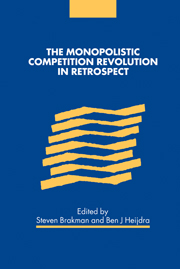Book contents
- Frontmatter
- Contents
- List of contributors
- Preface
- 1 Introduction
- Part I Underground classics
- Part II Current Perspectives
- Part III International trade
- Part IV Economic geography
- 10 The core–periphery model key features and effects
- 11 Globalisation, wages and unemployment: a new economic geography perspective
- 12 Empirical research in geographical economics
- 13 The monopolistic competition model in urban economic geography
- Part V Economic growth
- Part VI Macroeconomics
- Index
13 - The monopolistic competition model in urban economic geography
Published online by Cambridge University Press: 22 September 2009
- Frontmatter
- Contents
- List of contributors
- Preface
- 1 Introduction
- Part I Underground classics
- Part II Current Perspectives
- Part III International trade
- Part IV Economic geography
- 10 The core–periphery model key features and effects
- 11 Globalisation, wages and unemployment: a new economic geography perspective
- 12 Empirical research in geographical economics
- 13 The monopolistic competition model in urban economic geography
- Part V Economic growth
- Part VI Macroeconomics
- Index
Summary
Introduction
The development of the modern monopolistic competition model by Dixit and Stiglitz (1977), as well as by Spence (1976), started as a key innovation in industrial organisation. It provides a rigorous version of the Chamberlin–Robinson model of imperfect competition and clarifies long-standing issues such as whether, in fact, markets will generate too many varieties of differentiated products. But it quickly became apparent that the neat technical form to the model has other, perhaps even more important uses. The framework provides a convenient forum to model both scale economies in trade and growth models and the role of transport costs in trade models. These considerations led later to the formulation of the ‘new’ economic geography and to innovations in more traditional urban economics. While Dixit or Stiglitz cannot be praised nor held accountable for these developments per se, they would not have occurred in a timely fashion, without the Dixit–Stiglitz model. In this review, I focus on applications of Dixit–Stiglitz in urban modelling, so much of the discussion evaluates work by researchers such as Fujita, Krugman, Venables and their students.
There are two main types of applications in urban economic analysis. First are Krugman's (1991) core–periphery model and its urban variants by Krugman (1993) and Fujita, Krugman and Mori (1999). The core–periphery model is used extensively to model regional interactions, but also is interpreted widely as modelling urban phenomena.
- Type
- Chapter
- Information
- The Monopolistic Competition Revolution in Retrospect , pp. 285 - 304Publisher: Cambridge University PressPrint publication year: 2001



